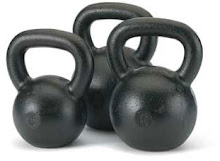Anti-extension is important because if I go up to grab a pass in football, it is my core that must be the braking system and keep my body from extending back into a pretzel. The ab wheel is one of the few infomercial items that actually work in this regard. It trains pure anti-extension. However, although I love my ab wheel, it doesn’t train the core in a dynamic enough matter for many athletes and many athletes are too weak to perform it safely and correctly.

Part of my training consists of heavy kettlebell swings. To perform the swing correctly, after extending my hips , I was contracting my abdominals hard at the top to make sure I wasn’t thrown into hyper extension by the 88-lb kettlebell. Lo and behold, for each rep, I concentrated more on this mechanism, realizing that it directly mimicked anti-extension in quite a few sports. This movement was done dynamically and with heavy forces acting upon it within a movement that involved hip extension and the almighty posterior chain. I can already feel the good pain in my abdominals, which means they were highly activated.
Check this quote out by Charlie Francis: “In sprinting, abdominal strength is critical to success. If the abdominals fail in the late stages of the race, the athlete will begin to lean back in an attempt to maintain knee lift. The backward lean causes the foot strike to occur too far ahead of the center of gravity. This results in deceleration and overstress of the hamstrings, potentially leading to injury. Strength and endurance in the abdominal muscles can be developed relatively quickly with EMS.” Although we aren’t using EMS here, you can see how the braking system can be developed dynamically for an activity like sprinting using anti-extension in the kettlebell swing.
I’m going to go out on a limb and say this movement is more beneficial to athletes than the ab wheel and it can be taught and performed at a much younger training age. Most athletes and trainees can perform kettlebell swings at a relatively young training age due to the fact that once they ‘get’ hip extension and can keep the lower back in neutral, they can usually put it together to do light kettlebell swings. I have taught 9 year olds how to swing a kettlebell, and frankly, there is no good reason not to teach this from an early age. Don't kid yourself, the forces exerted upon your 9 year during his peewee football game are likely greater than that of a kettlebell swing. So why the hell do you just have your kid playing a dynamic, powerful sport...with no preparation in mechanics or physiology?
Next time you take your kettlebells out for a spin, be sure to put on the anti-extension brakes with the abdominals. This will give you more bang for your buck and help to injury proof you or your athletes.



No comments:
Post a Comment